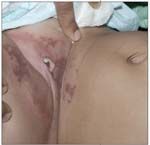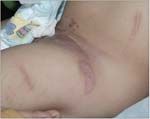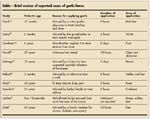Child With Bullous Lesion on Left Side of Groin
A 16-month-old Hispanic girl presented with a 2-day history of pain, redness, and swelling of the left side of her groin. Her mother first noticed the lesion after the child was seen limping and scratching the area. The mother thought her child had been bitten by an insect but did not witness any bite.
FIGURE 1

A burn and a central 1 × 1-cm clear fluid-filled bullous lesion can be seen on the left side of the patient's groin. FIGURE 2

Scratches on the lower thigh and a healed burn were incurred when the child fell onto an electric heater 4 months before the current episode.
A 16-month-old Hispanic girl presented with a 2-day history of pain, redness, and swelling of the left side of her groin. Her mother first noticed the lesion after the child was seen limping and scratching the area. The mother thought her child had been bitten by an insect but did not witness any bite. The redness spread with areas of discoloration, and a blister developed the next morning.
There was no known history of discharge from the lesion, trauma to the area, or thermal burn. The mother denied applying any lotions, creams, or medications to the area. The child had been previously healthy, and her immunizations were up-to-date.
The child appeared well-nourished and had normal vital signs. She cried during attempts to examine her groin, which showed a 10 × 6-cm area of redness, induration, and tenderness with hyperpigmentation. A central 1 × 1-cm clear fluid-filled bullous lesion was also noted (Figure 1). Skin folds were spared. The child also had scratch marks on her left thigh. There was an old patterned burn mark on the left thigh and flank. The mother reported that the burn had been sustained 4 months earlier when the child fell onto an electric heater (Figure 2). The mother had not brought her daughter for medical attention at that time. There was no inguinal lymphadenopathy.
White blood cell count, 20,800/µL, with 50% neutrophils, 35% lymphocytes; hematocrit, 39.1%; platelet count, 562,000/µL.
What causes would you consider in your differential diagnosis?
(Answer and discussion begin on next page.)
This child was initially admitted to our hospital with a diagnosis of cellulitis. However, a chemical burn also was suspected based on the appearance of the area with sparing of the creases. The patient was treated with intravenous clindamycin and topical silver sulfadiazine.
Child abuse and neglect was later suspected because of the inconsistency between the history and the physical findings, including the old patterned burn. Social work and child protection teams were consulted and agreed with the assessment. A skeletal survey was done, which showed normal density of the bones with no evidence of fracture.
The redness and induration were substantially diminished on day 2 of admission. At that time, a 2 3 3-cm tender, warm, fluctuant mass was noted in the left groin, and inguinal abscess was diagnosed. The abscess was drained and the area debrided. Culture of the drained fluid grew Staphylococcus aureus. The child's blood culture showed no growth. Therapy with intravenous clindamycin and topical sulfadiazine was continued.
On further questioning on day 2 of admission, the mother remembered that she had applied fresh crushed garlic directly to the child's skin overnight on the first day of symptoms to treat the suspected insect bite. She did so based on advice from the patient's grandmother in Mexico. The crushed garlic was covered tightly by the child's diaper.
This child had a second-degree burn of the groin caused by the crushed garlic. Burns resulting from garlic applications have been reported in the literature. This is the first reported case in which a burn caused by garlic led to suspicion of child abuse and neglect.
We believe the original lesion was an insect bite, which resulted in an inguinal abscess that was not palpable on the child's initial presentation. The abscess was noticed and drained the following day. Because of the associated pain and scratching, the mother applied the garlic to the affected area. No one witnessed the insect bite, however; thus, the inguinal abscess is the only documented cause.
The child was discharged home on day 5. Her discharge medications were oral cephalexin and topical bacitracin. At follow-up with the pediatrician 5 days later, the burn was healing well with no scarring. Child Protective Services visited the home and found no further evidence to suspect child abuse or neglect. The mother was compliant with medical treatment, and the case was closed.
COMPLEMENTARY AND ALTERNATIVE MEDICINE
The use of complementary and alternative medicine (CAM) among children is significant (estimates range from 12% to 70%).1 In children, the most commonly used CAM therapies are herbal and folk home remedies.2
Garlic (Allium sativum)--also known as "the spice of life" and the "stinking rose"--is one of the earliest documented plants used to maintain health and to prevent and treat disease.3,4 Almost every early civilization has used garlic as part of its therapeutic regimens.3 Garlic has been used for thousands of years in India, Egypt, Greece, China, Rome, and Japan.5 Garlic has been used to treat a variety of maladies, including respiratory complaints, animal bites, parasites, fatigue, leprosy, and depression.1 In addition to its potential medical applications, garlic was thought to provide strength, enhance athletic performance, and increase courage.3
Chemical burns have been recognized as an adverse effect of applying garlic to the skin, particularly when the garlic is mashed and applied for extended periods in a poultice. Such was the case with our patient.
MEDICINAL GARLIC
Garlic continues to have a role as an herbal remedy in many cultures and is prescribed by naturopathic physicians for a variety of medical reasons.5 Currently, research is being done on the potential use of garlic and is affirming the validity of ancient medical practices.5 It is now used for its presumed cardiovascular, anti-neoplastic, and antimicrobial properties.6 Like many herbs, however, garlic it is not without adverse effects. Garlic has been reported to cause bronchospasm, nausea, vomiting, diarrhea, hypoglycemia, contact dermatitis, and chemical burns.6-16
We found 10 cases reported in the literature since the first report of a garlic burn by Parish and colleagues in 1987.7-16 The Table lists these cases and includes the patients' ages and reasons for garlic application. Four cases involved children aged 3 months to 6 years.10,14-16 The type and degree of the injury to the skin was influenced by the concentration and duration of the garlic applied, freshness of the garlic, anatomic area, and concurrent skin conditions.12 All cases involved the application of fresh garlic cloves--whether crushed or mixed with petroleum. In all cases, garlic was applied firmly to the skin with adhesive bands, films, or towels for at least 3 hours.
TABLE

Brief review of reported cases of garlic burns
We believe our patient's case represents the first in which a garlic burn triggered suspicion of child abuse.
Folk remedies are well recognized as potential sources of confusion with child abuse.17 A case of circumferential burns of the ankle and foot was reported in a Hispanic girl by Nunez and Taff18 20 years ago. In this case, the patient's burns were caused by treatment of a sprained ankle with a variety of materials following the hot-cold Hispanic disease concept.18 This concept holds that pain is cold; therefore the child's ankle sprain was treated with heat (hot water), which resulted in burns. The (hot) burns, were subsequently treated with (cooling) toothpaste, which increased the severity of the burns.
Cupping, coining, scarification, therapeutic burning, and herbal remedies are other folk remedies that can be confused with child abuse.17 Although not intentionally abusive, some of these remedies may be also dangerous. The use of garlic as a poultice may have potential harmful effects and should be discouraged.
Pediatric burn injuries are not infrequently the result of abuse.19 An estimated 3% to 10% of pediatric burns are non-accidental.19 A high index of suspicion is important because up to 30% of children who are repeatedly burned die as a result.19 As with other non-accidental injuries, the history and the pattern of injury may arouse suspicion. An extensive history of how the burn occurred is vitally important in all cases--especially when child abuse or neglect is suspected.
Familiarity with CAM practices helps distinguish burns caused by abuse from those caused by inappropriate use of CAM. As the use of CAM (particularly herbal or folk remedies) increases among children,1,2 it is important to ask parents about the use of herbs, folk remedies, or other treatments as part of the routine pediatric history.
The Hispanic population is growing in the United States,20 and garlic is one of the most commonly used herbs by this group.20,21 The cultural belief of illness, which includes the belief in balance between hot and cold and the use of folk remedies is important to patients of Hispanic descent and can shape a patient's concept, treatment, and acknowledgement of certain illnesses.20 Some folk remedies used by the Hispanic population may be harmful or result in delay in seeking professional medical care.
Our case underscores the importance of cultural beliefs and their effect on health behaviors.22,23 Roy and associates24 reported that traditional health beliefs about home remedies, folk remedies, and self-medication held by guardians play an important role in their attitudes about their child's health care. In one study, nearly half of 2562 caregivers surveyed used herbs to treat their children.21 The most common sources of information on herbal remedies and treatments were other family members (78.9%) and friends (32.9%)--not health care professionals.21
Patients and parents may not tell the pediatrician that they are using CAM.1,25 For this reason, it is essential that queries about the use of CAM become an essential part of pediatric history taking. *
References:
REFERENCES:
1.
Sawni-Sikand A, Schubiner H, Thomas RL. Use of complementary/alternative therapies among children in primary care pediatrics.
Ambul Pediatr.
2002;2:99-103.
2.
Smitherman LC, Janisse J, Mathur A. The use of folk remedies among children in an urban black community: remedies for fever, colic, and teething.
Pediatrics.
2005;115:e297-304.
3.
Rivlin RS. Historical perspective on the use of garlic.
J Nutr.
2001;131(3S): 951S-954S.
4.
Hrastinger A, Dietz B, Bauer R, et al. Is there clinical evidence supporting the use of botanical dietary supplements in children?
J Pediatr.
2005;146:311-317.
5.
Rivlin RS. Is garlic alternative medicine?
J Nutr.
2006;136(3 suppl):713S-715S.
6.
Tattelman E. Health effects of garlic.
Am Fam Physician.
2005;72:103-106.
7.
Dietz DM, Varcelotti JR, Stahlfeld KR. Garlic burns: a not-so-rare complication of a naturopathic remedy?
Burns.
2004;30:612-613.
8.
Lachter J, Babich JP, Brookman JC, Factor AY. Garlic: a way out of work.
Mil Med.
2003;168:499-500.
9.
Baruchin AM, Sagi A, Yoffe B, Ronen M. Garlic burns.
Burns.
2001;27: 781-782.
10.
Rafaat M, Leung AK. Garlic burns.
Pediatr Dermatol.
2000;17:475-476.
11.
Hviid K, Alsbjorn B. "Burns" caused by local application of garlic [in Danish].
Ugeskr Laeger.
2000;162:6853-6854.
12.
Roberge RJ, Leckey R, Spence R, Krenzelok EJ. Garlic burns of the breast.
Am J Emerg Med.
1997;15:548.
13.
Farrell AM, Staughton RC. Garlic burns mimicking herpes zoster.
Lancet.
1996;347:1195.
14.
Canduela V, Mongil I, Carrascosa M, et al. Garlic: always good for the health?
Br J Dermatol.
1995;132:161-162.
15.
Garty BZ. Garlic burns.
Pediatrics.
1993;91:658-659.
16.
Parish RA, McIntire S, Heimbach DM. Garlic burns: a naturopathic remedy gone awry.
Pediatr Emerg Care.
1987;3:258-260.
17.
Hansen KK. Folk remedies and child abuse: a review with emphasis on caida de mollera and its relationship to shaken baby syndrome.
Child Abuse Negl.
1998; 22:117-127.
18.
Nunez AE, Taff ML. A chemical burn simulating child abuse.
Am J Forensic Med Pathol.
1985;6:181-183.
19.
Hettiaratchy S, Dziewulski P. ABC of burns: pathophysiology and types of burns.
BMJ.
2004;328:1427-1429.
20.
Risser AL, Mazur LJ. Use of folk remedies in a Hispanic population.
Arch Pediatr Adolesc Med.
1995;149:978-981.
21.
Lohse B, Stotts JL, Priebe JR. Survey of herbal use by Kansas and Wisconsin WIC participants reveals moderate, appropriate use and identifies herbal education needs.
J Am Diet Assoc.
2006;106:227-237.
22.
Pachter LM. Culture and clinical care. Folk illness beliefs and behaviors and their implications for health care delivery.
JAMA.
1994;271:690-694.
23.
Patcher L.
Ethnic and Cultural Influences on Child Health Services.
5th ed. Philadelphia: WB Saunders Company; 1999.
24.
Roy LC, Torrez D, Dale JC. Ethnicity, traditional health beliefs, and health-seeking behavior: guardians' attitudes regarding their children's medical treatment.
J Pediatr Health Care.
2004;18:22-29.
25.
Ottolini MC, Hamburger EK, Loprieato JO, et al. Complementary and alternative medicine use among children in the Washington, DC area.
Ambul Pediatr.
2001;1:122-125.
Recognize & Refer: Hemangiomas in pediatrics
July 17th 2019Contemporary Pediatrics sits down exclusively with Sheila Fallon Friedlander, MD, a professor dermatology and pediatrics, to discuss the one key condition for which she believes community pediatricians should be especially aware-hemangiomas.